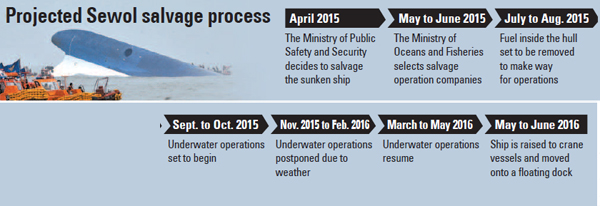Gov’t approves outline to salvage the Sewol ferry

The Central Disaster and Safety Countermeasure Headquarters decided in a meeting Wednesday at the Seoul Government Complex in central Seoul to salvage the ship within an appropriate time frame, effectively passing the plan proposed by the Ministry of Oceans and Fisheries.
“We decided to salvage the Sewol ferry in accordance with the wishes of the victims’ families and the public,” said Park In-yong, the minister of Public Safety and Security who heads the countermeasure headquarters. “The salvage operation is expected to take 12 to 18 months and cost 100 to 150 billion won ($93 to $139 million).”
He added that the total expense was expected to increase by 50 billion won if the operation was extended by six months and could potentially surpass 200 billion won, leading to concerns over funding.
The government plans to initially put forth its own budget and retrieve the insurance money intended for Chonghaejin Marine Company, which operated the sunken ferry.
The headquarters reviewed the plan in detail, including the method for salvaging the ship, associated risks and uncertainties, estimated expenses, budget plans and follow-up measures after the operation.
Expert opinions as well as those of the victims’ families were also taken in account.
The Ministry of Oceans and Fisheries said the salvage operation is technically possible based on its report and suggested raising the shipwreck as it is, using crane vessels and a portable floating dock rather than cutting the hull into pieces and raising it to the surface in shifts.
Raising the vessel intact, it added, will minimize the risk of losing the contents inside the ship, including possible remains of the nine passengers still technically missing.
The Ministry of Oceans and Fisheries is planning to look for suitable salvage companies both in and outside of Korea and is also considering creating a consortium consisting of domestic and foreign operators.
No domestic salvage operators are capable of carrying out the operation independently.
After the selection process, it will finalize a plan and make preparations for the operation, which is set to begin on-site work in September at the earliest. It is unprecedented to raise a ship weighing nearly 10,000 tons, including its cargo, without breaking it into pieces, especially in a sea with rapid currents. Still, experts have expressed optimism about the plan.
“It’s very hard to say the exact success rate, but it looks good based on the data we have collected over the past four to five months,” said Managing Director Stephen Tierney of TMC Marine, an international marine consultancy. “I would say it’s more than 50 percent.”
Relatives of the victims welcomed the decision on Wednesday but remained critical of the government.
“Even though it’s been six months since the government told us the shipwreck would be salvaged, we still welcome the decision,” said Yoo Gyeong-geun, an official of the 4/16 Sewol Families for Truth and a Safer Society, an organization set up for the victims.
“But we also demand the government continue to communicate with the relatives and keep the process transparent.”
“[The salvage operation] is the one thing the government has neglected but is going ahead with because of the public opinion surrounding the issue,” he continued. “We don’t want to see the government acting like it’s doing us a huge favor or making a difficult decision.”
BY KIM BONG-MOON [kim.bongmoon@joongang.co.kr]










with the Korea JoongAng Daily
To write comments, please log in to one of the accounts.
Standards Board Policy (0/250자)